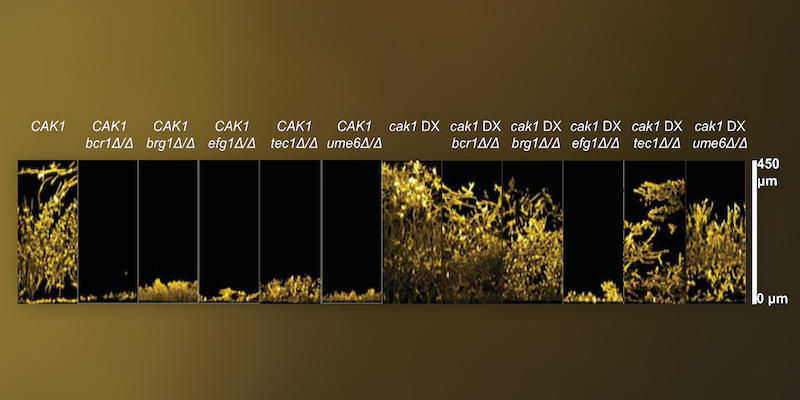Inhibition of Pathogen Growth Can Promote Pathogenic Traits

Many infections by bacteria and fungi arise from the ability of these microorganisms to grow on a surface. The surfaces can be on man-made devices, such as an artificial joint or an implanted catheter, or they can be on biological tissues, such as the tongue. Microbes that grow on these surfaces are called a biofilm, and biofilm cells are well known to have distinctive properties, including a high tolerance for antimicrobial drugs. An investigation led by Carol Woolford in our department has revealed an unexpected feature of biofilm growth that helps to explain the resilience of biofilm cells when they encounter growth inhibitors.
The new study, published in PLOS Genetics, is the latest paper from the long-standing collaboration between the Mitchell and Lanni labs to discover the fundamental properties of biofilms of the fungus Candida albicans. This fungus is a normal inhabitant of our genitourinary and gastrointestinal tracts. It can overgrow to cause painful and life-threatening infections in patients suffering from cancer, AIDS, Diabetes mellitus, and many other conditions. One major route of infection is through its biofilm growth on implanted medical devices.
Woolford and colleagues used a genetic trick to understand the roles of a class of protein, called protein kinases, in C. albicans biology. A panel of strains was created, each of which had diminished expression of a different protein kinase. Surprisingly, many of these strains assumed biofilm-like growth and expressed biofilm-related genes in the absence of the usual signals that induce biofilm formation.
Strikingly, for the Cak1 protein kinase, which was studied in detail, diminished expression overcame the requirement for most of the key biofilm regulators previously described. This protein kinase, Cak1, is a central regulator of cell cycle progression, and complete ablation of Cak1 activity is likely lethal to the fungus. The results indicate that partial inhibition of a central growth control pathway, as might occur if drug treatment is too infrequent, can augment the very pathogenic traits that cause infection in the first place. The findings illustrate how a study aimed at a basic science question can have clear clinical implications.
Woolford's collaborators on this project include Aaron Mitchell and Fred Lanni, as well as Ph.D. student Katie Lagree, former postdoctoral fellow Wenjie Xu, and research technician Tatyana Aleynikov, all from CMU. Additional collaborators included Hema Adhikari and Paul J. Cullen from the University at Buffalo, and Hiram Sanchez and David R. Andes from the University of Wisconsin.
––––––––
Image: Augmented Candida biofilm formation as a result of reduced Cak1 expression. Strains were grown under biofilm conditions for 48 hr, then visualized by confocal microscopy. Cross-sectional views are shown. Biofilm regulatory mutations bcr1Δ/Δ, brg1Δ/Δ, efg1Δ/Δ, tec1Δ/Δ, and ume6Δ/Δ block biofilm formation when Cak1 kinase levels are normal (CAK1 strains), but have limited impact when Cak1 kinase levels are diminished (cak1 DX strains).
Citation: Woolford CA, Lagree K, Xu W, Aleynikov T, Adhikari H, Sanchez H, et al. (2016) Bypass of Candida albicans Filamentation/Biofilm Regulators through Diminished Expression of Protein Kinase Cak1. PLoS Genet 12(12): e1006487. doi:10.1371/journal.pgen.1006487